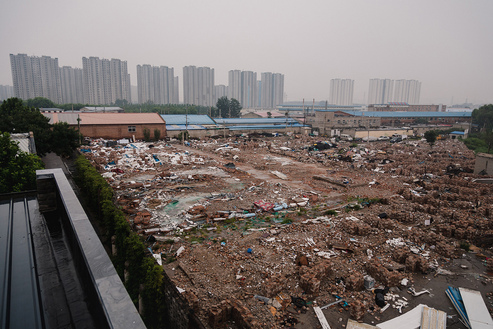
R
E
V N
E
X
T
Huang Rui, one of China’s forerunners in contemporary art and co-founder of the Stars art group in 1979, knew that this day would come. Ten years after building his magnificent studio in 2007 on what was then empty land, not far from a countryside village and an acrid recycling business, and within reasonable distance from Beijing’s 798 Art Zone, Huang received notice from the local government signalling that the studio was slated for demolition. The artist is of the opinion that the move is part of Chinese president Xi Jinping’s afforestation campaign launched in 2015, with the aim to plant billions of trees to create a green necklace around Beijing and combat the city’s severe air pollution. To the north of the studio, bulldozers cleared land when the campaign was initiated, and thousands of trees were planted there. To the south, an enclave of several warehouses that nestled Huang’s studio has been razed over the past few weeks.
Since 2007, Huang has received several similar notices pointing out that the studio was illegally constructed—he readily accepts that it is—but no official action was ever taken. However, his tenancy is precarious, and the artist has expressed his concern that a peremptory notice might arrive with orders for him to vacate. Now the bulldozers are at the studio’s front door. Speaking today by phone with ArtAsiaPacific from his studio, Huang admitted that he is desperate to find a solution for what appears to be an intractable problem.
“I have written to the local government several times, suggesting that rather than demolish the building, it could be turned into some form of cultural center,” the artist said. “Or also a form of heritage building, an example of a modern courtyard house. This is just one idea that might just save the building. But they have not replied.”
At 50 meters in length, the studio was constructed from Qing- and Ming-dynasty bricks salvaged from the hutongs that were being demolished in Beijing in the lead-up to the 2008 Beijing Olympic Games. Bricks from the very hutong that Huang lived in as a child were rescued and incorporated into the studio’s walls. Neville Mars of Mars Architects in Shanghai designed the structure, and suggested to ArtAsiaPacific by phone that the building’s heritage provided good reason to save the building even though it was only built ten years ago: “We used 200,000 authentic, hand-made, dense gray bricks that are not available now to achieve a modern interpretation of a courtyard house. It is enclosed from the outside, but every inner room opens onto a central courtyard that is both secluded and private. We wanted to make an environment where creativity and living is correlated. The building was an empty canvas—in many ways a barren structure that Rui has made into a home and studio by adding paintings and his extensive collection of 20th century furniture,” Mars said.
Beijing has expanded exponentially, and the city has wrapped itself around Huang’s studio. Ten years ago, the rural periphery of Beijing provided a foothold for the influx of workers. Now with the development of the green belt, those workers have also been driven out, according to Mars.
There is a certain resignation in Huang’s voice: “Every week, art districts near my house are being destroyed. Trees grow so slowly. But demolition here happens so fast.”
In 2002, Huang established a studio in the then-vacant and partially derelict Dashanzi factory area—now the famous 798 Art Zone—and then successfully campaigned to save the district when it was threatened by government demolition in 2004.
Michael Young is a contributing editor of ArtAsiaPacific.
To read more of ArtAsiaPacific’s articles, visit our Digital Library.




